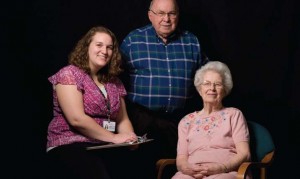Last week, I wrote about serendipitously discovering the work of Primary Care Progress, a grassroots physician advocacy group trying to strengthen primary care. The serendipity continued shortly after I saw their work in cyberspace, when I got a chance to meet some of its leaders in the real world (in Philadelphia). Because of the Foundation’s belief that enhanced primary care is one of the essential pillars for improving the health of older Americans, last Monday I attended a meeting sponsored by the American Board of Internal Medicine Foundation. The topic: returning joy to primary care.
You might wonder how returning joy to physicians and other people working in primary care (although most meeting attendees were MDs) would relate to the Foundation’s mission of improving the health of older Americans. But I think the evidence is clear that people who enjoy their work do it better, stay in their careers, and make the work seem more attractive to others. And, if we are to provide the kind of comprehensive and proactive primary care that older adults need, we certainly need more primary care providers (of all professions) who really want to do it.
At the Foundation, we have invested significantly in research and training to try to discover how primary care can better support healthy aging. Projects like IMPACT, Care Management Plus, Guided Care, and the Practicing Physician Education initiative have all tried to make that happen. Other projects such as Indiana University’s GRACE and the Atlantic Philanthropies-funded ACOVE Prime have also offered important lessons on how to make primary care more aging-friendly. We continue to be very interested in how reinvestment in primary care careers, improved payment, and systems redesign can make this critical part of the health care system better able to serve the older adult population. And, of course, we are very aware of the defects and frustrations of primary care as it often very ineffectively tries to serve older people, as I've written about here and here. (In a few weeks the Foundation will be releasing the results of its first-ever poll of the experience of primary care by older adults that we hope will shed some additional light on this topic.)
discover how primary care can better support healthy aging. Projects like IMPACT, Care Management Plus, Guided Care, and the Practicing Physician Education initiative have all tried to make that happen. Other projects such as Indiana University’s GRACE and the Atlantic Philanthropies-funded ACOVE Prime have also offered important lessons on how to make primary care more aging-friendly. We continue to be very interested in how reinvestment in primary care careers, improved payment, and systems redesign can make this critical part of the health care system better able to serve the older adult population. And, of course, we are very aware of the defects and frustrations of primary care as it often very ineffectively tries to serve older people, as I've written about here and here. (In a few weeks the Foundation will be releasing the results of its first-ever poll of the experience of primary care by older adults that we hope will shed some additional light on this topic.)
One of the best parts of the meeting was, of course, hearing from some luminaries of primary care redesign. These include the Southcentral Foundation in Alaska, Fairview in Minneapolis, and the new South Huntington model practice of the Brigham and Women’s system in Boston. All of these practices have a few key attributes in common: high functioning teams; work designs that allow all staff to perform at the top of their licenses (i.e., with maximum responsibility); and the win-win of improved patient outcomes combined with financial and operational success for the practices. I was particularly proud that all of them were using some aspects of the primary care models supported by the Foundation. For example, they all had integrated mental health care using collaborative practice that was either an explicit implementation of, or at least loosely inspired by, the IMPACT model.
As I listened, this list of key attributes for the successful primary care management of older adults popped out at me:
- Co-located Comprehensive Care Teams, including:
- Mental health/social work
- Pharmacy
- RNs and/or medical assistants with delegated authority
- Co-management of complex patients
- Specialist consultation (e.g., geriatrician, psychiatrist)
- Explicit Team Process:
- Daily (or more) brief huddles to plan work
- Formal team meetings weekly or monthly
- Joint accountability – transparency of goals
- Quality Improvement Culture
- Careful use of resources, including personnel time
- Visual management, making quality data public
- Including the voice of the patient/customer
I hope the members of Primary Care Progress in attendance (Andrew Morris-Singer, David Margolius, and David Gellis) were as excited by these model practices as I was. They offer a road map to the improved primary care that we and they envision for the future. Primary Care Progress’s members—medical students and residents who are committed not only to becoming primary care providers but also to creating a movement to attract others—will be the leaders who will be implementing that better future.
Moving forward I would like to see us find the special elder care nuances of the attributes I listed, and by connecting our geriatric care experts to primary care innovators, assure that primary care can joyfully meet its commitments to older adults.
